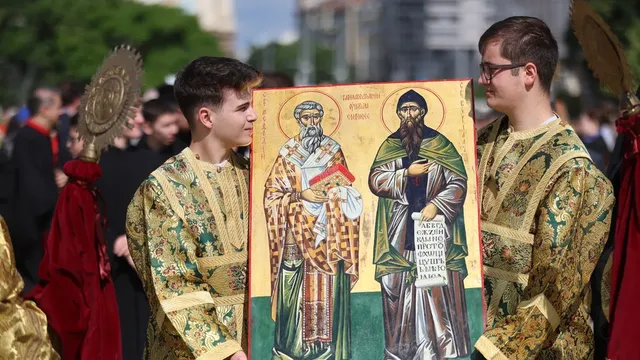On May 24, Bulgaria celebrates the Day of Bulgarian Education and Culture and of Slavic Script.
This national holiday honors education, culture, and the creation of the Glagolitic alphabet by Saints Cyril and Methodius — also known as the "Brothers from Solun (Thessaloniki)." The first translations of the Holy Scriptures by Cyril and Methodius were written in Glagolitic, the original Slavic script.
The earliest known reference to the celebration dates back to an Armenian chronicle from 1813, which mentions a commemoration of the two saints on May 22, 1803, in the Bulgarian town of Shumen. The first officially organized celebration took place on May 11, 1851, at the diocesan school "Saints Cyril and Methodius" in Plovdiv, initiated by the Bulgarian educator Nayden Gerov. The date — May 11 — was chosen intentionally, as it corresponds to the shared feast day of the saints in the Orthodox Church calendar.
In Bulgarian literature of the National Revival, the earliest mention of the celebration appears in Neofit Rilski’s 1852 "Slavic Language Reader". In 1857, the day was honored with a religious service in the Bulgarian church St. Stephen in Constantinople, along with a commemoration of St. John of Rila. In 1858, the celebration reached Plovdiv, where teacher Yoakim Gruev delivered a passionate speech on the lives and legacy of the two brothers after a solemn church service.
The holiday began to spread regularly across Bulgarian-populated towns like Shumen, Lom, and Skopje (from 1860). In 1863, May 11 was officially recognized by the Orthodox Church as the feast day of the Equal-to-the-Apostles Saints Cyril and Methodius. In Sofia, the celebrations were organized by teacher Sava Filaretov.
During the struggle for church independence in the 18th and 19th centuries, the legacy of Cyril and Methodius served not only as inspiration but also as a political argument against the Greek-dominated Ecumenical Patriarchate. As Hristo Botev noted in one of his articles, the celebration of the saints came to symbolize the future Bulgarian national and ecclesiastical independence.
Over time, the celebration moved beyond schools and churches to become a national cultural holiday. After the liberation of Bulgaria in 1878, the commemoration of the saints took two forms: in free Bulgaria, it became mostly a school holiday, while in Macedonia and Eastern Thrace, it continued to function as an expression of Bulgarian identity and resistance to Ottoman rule and foreign (Serbian and Greek) assimilationist propaganda.
After World War I, the holiday gained even greater importance. With the adoption of the Gregorian calendar in 1916, May 24 became the unified date for the celebration, observed both by the state and the Church. Since 1969, the Church and the secular state have celebrated the day separately — May 11 remains the religious holiday, while May 24 is recognized as the secular Day of Bulgarian Education, Culture, and Slavic Script.
May 24 was officially declared a public holiday of the People’s Republic of Bulgaria by the 9th National Assembly on March 30, 1990. After the country’s transition to democracy, on November 15, 1990, it was proclaimed an official holiday of the Republic of Bulgaria.
The earliest records of the celebration of May 11 as the feast of Saints Cyril and Methodius date back to the 12th century, and the two were canonized as saints as early as the 9th century. Individually, St. Cyril is commemorated on February 14, and St. Methodius on April 6, the respective days of their deaths.
The All-Russian Synod, marking the millennium of the Moravian mission of Cyril and Methodius, decreed in 1863 that May 11 be established as an annual church holiday:
"In remembrance of the millennium since the Gospel and the Christian faith first enlightened our ancestral language, May 11 shall henceforth be a church holiday in honor of the venerable Saints Cyril and Methodius."
Since then, the holiday has been celebrated across all Slavic Orthodox nations.
During the Bulgarian National Revival, the holiday was observed not only in the homeland but also among the diaspora — in Romania, Russia, among Bulgarian students abroad, and even by exiled Bulgarians in Diyarbakır. In 1856, teacher Yoakim Gruev proposed that the day of Saints Cyril and Methodius be celebrated specifically as a holiday for Bulgarian students.
In 1892, Stoyan Mihaylovski composed the lyrics of the school hymn beginning with the famous line “Go forth, revived people” ("Върви, народе възродени"). Originally titled "Hymn to Saints Cyril and Methodius", it included 14 verses, of which the first six are most commonly sung today. On May 11, 1900, composer Panayot Pipkov wrote the music for the hymn, which remains one of Bulgaria’s most beloved and symbolic anthems.
Today, May 11 is celebrated by the Orthodox Church as the feast of Saints Cyril and Methodius, while May 24 is established as the secular holiday dedicated to Slavic script, Bulgarian education, and national culture.
May 24 is also celebrated in Russia, where the holiday was first officially observed in 1986 at the initiative of Vitaly Maslov, a writer from Murmansk — the northernmost place where a monument to Saints Cyril and Methodius stands.
Cyril and Methodius were canonized for their translation and dissemination of the Bible into Old Church Slavonic (which later evolved in Russia as Church Slavonic) and for spreading Christianity among the Slavs. They have been declared patrons of Europe by the Pope, and are venerated in the Orthodox Church as two of the Seven Saints (Sedmochislenitsi). | BGNES

 Breaking news
Breaking news
 Europe
Europe
 Bulgaria
Bulgaria







